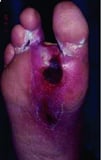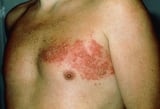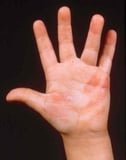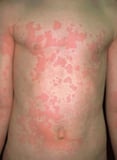Bumps on Skin and Skin Changing Color
Topic Resources
Doctors use specific terms to describe various types of marks and growths on the skin. Some skin disorders and infections can cause color changes in the skin.
Atrophy is thinning of the skin that can sometimes result in a depression and often has a dry and wrinkled "cigarette paper" appearance.
Bullae are clear fluid-filled blisters that are greater than 10 millimeters (0.4 inch) in diameter (larger than vesicles).
Crusts (scabs) are dried blood, pus, or skin fluids on the surface of the skin. A crust can form wherever the skin has been damaged.
Cysts are thin-walled cavities filled with liquid or semi-liquid material. They often look and feel like a lump (nodule) in the skin.
Excoriations are erosions caused by scratching, rubbing, or picking at the skin. Often, excoriations are covered with a crust.
Lesion is a general term for any abnormal mark or growth on the skin.
Lichenification is thickened skin that has accentuated skinfolds or creases that appear as deep grooves and wrinkles. Lichenification is caused by repeated scratching or rubbing.
Macules are flat, discolored spots of any shape less than 10 millimeters (0.4 inch) in diameter. Freckles, flat moles, port-wine stains, and many rashes are macular.
Nodules are solid raised areas that are usually round. They are deeper and easier to feel than papules. A nodule sometimes appears to form below the surface of the skin and press upward.
Patches are larger flat spots (greater than 10 millimeters).
Plaques are flat or raised areas or groups of small bumps (papules) typically more than 10 millimeters (0.4 inch) in diameter.
Pustules are fluid-filled spots (vesicles) containing pus.
Telangiectases are dilated blood vessels near the surface of the skin that often have a twisted appearance and that whiten (blanch) when pressure is applied.
Ulcers are similar to erosions, only deeper, penetrating at least part of the dermis. The causes are the same as for erosions, but conditions that impair healing, such as venous stasis Infectious problems in diabetes People with diabetes mellitus have many serious long-term complications that affect many areas of the body, particularly the blood vessels, nerves, eyes, and kidneys. (See also Diabetes Mellitus... read more  , diabetes Complications of Diabetes Mellitus People with diabetes mellitus have many serious long-term complications that affect many areas of the body, particularly the blood vessels, nerves, eyes, and kidneys. (See also Diabetes Mellitus... read more
, diabetes Complications of Diabetes Mellitus People with diabetes mellitus have many serious long-term complications that affect many areas of the body, particularly the blood vessels, nerves, eyes, and kidneys. (See also Diabetes Mellitus... read more  , peripheral artery disease Overview of Peripheral Arterial Disease Peripheral arterial disease results in reduced blood flow in the arteries of the trunk, arms, and legs. Most often, doctors use the term peripheral arterial disease to describe poor circulation... read more
, peripheral artery disease Overview of Peripheral Arterial Disease Peripheral arterial disease results in reduced blood flow in the arteries of the trunk, arms, and legs. Most often, doctors use the term peripheral arterial disease to describe poor circulation... read more  , and vasculitis Overview of Vasculitis Vasculitic disorders are caused by inflammation of the blood vessels (vasculitis). Vasculitis can be triggered by certain infections or drugs or can occur for unknown reasons. People may have... read more
, and vasculitis Overview of Vasculitis Vasculitic disorders are caused by inflammation of the blood vessels (vasculitis). Vasculitis can be triggered by certain infections or drugs or can occur for unknown reasons. People may have... read more  , are also often involved. Ulcers usually heal with scarring.
, are also often involved. Ulcers usually heal with scarring.
Vesicles are small, clear fluid-filled blisters less than 10 millimeters (0.4 inch) in diameter. Bullae are vesicles larger than 10 millimeters in diameter. Herpes zoster (shingles Shingles Shingles is a painful skin rash caused by a viral infection that results from reactivation of the varicella-zoster virus, the virus that causes chickenpox. What causes the virus to reactive... read more  ), chickenpox Chickenpox Chickenpox is a highly contagious viral infection with the varicella-zoster virus that causes a characteristic itchy rash, consisting of small, raised, blistered, or crusted spots. Chickenpox... read more
), chickenpox Chickenpox Chickenpox is a highly contagious viral infection with the varicella-zoster virus that causes a characteristic itchy rash, consisting of small, raised, blistered, or crusted spots. Chickenpox... read more  , burns Burns Burns are injuries to tissue that result from heat, electricity, radiation, or chemicals. Burns cause varying degrees of pain, blisters, swelling, and skin loss. Small, shallow burns may need... read more
, burns Burns Burns are injuries to tissue that result from heat, electricity, radiation, or chemicals. Burns cause varying degrees of pain, blisters, swelling, and skin loss. Small, shallow burns may need... read more  , allergic reactions Overview of Allergic Reactions Allergic reactions (hypersensitivity reactions) are inappropriate responses of the immune system to a normally harmless substance. Usually, allergies make people sneeze; the eyes water and itch... read more
, allergic reactions Overview of Allergic Reactions Allergic reactions (hypersensitivity reactions) are inappropriate responses of the immune system to a normally harmless substance. Usually, allergies make people sneeze; the eyes water and itch... read more  , and irritations form vesicles and bullae.
, and irritations form vesicles and bullae.
Orange skin is most often the result of hypercarotenemia. Hypercarotenemia is a condition that is the result of too much of the pigment carotene in the blood. People who overeat foods rich in beta-carotene, such as carrots, may develop hypercarotenemia.
| Generic Name | Select Brand Names |
|---|---|
| minocycline | MINOCIN |
| amiodarone | CORDARONE |
CLICK HERE FOR THE PROFESSONAL VERSION

© 2021 Merck Sharp & Dohme Corp., a subsidiary of Merck & Co., Inc., Kenilworth, NJ, USA
Was This Page Helpful?
Bumps on Skin and Skin Changing Color
Source: https://www.merckmanuals.com/home/skin-disorders/biology-of-the-skin/descriptions-of-skin-marks-growths-and-color-changes
0 Response to "Bumps on Skin and Skin Changing Color"
Post a Comment